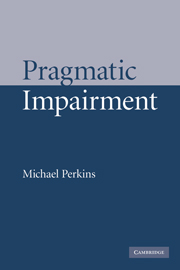Book contents
- Frontmatter
- Contents
- List of figures
- List of tables
- Acknowledgements
- Transcription conventions
- 1 Introduction
- 2 Pragmatic theory and pragmatic impairment
- 3 Pragmatics and modularity: components, dissociations and associations
- 4 Pragmatic ability and disability: an emergentist model
- 5 Cognition and pragmatics
- 6 Language and pragmatics
- 7 Sensorimotor systems and pragmatics
- 8 Compensatory adaptation
- 9 Conclusions
- Appendix
- References
- Index
8 - Compensatory adaptation
Published online by Cambridge University Press: 22 September 2009
- Frontmatter
- Contents
- List of figures
- List of tables
- Acknowledgements
- Transcription conventions
- 1 Introduction
- 2 Pragmatic theory and pragmatic impairment
- 3 Pragmatics and modularity: components, dissociations and associations
- 4 Pragmatic ability and disability: an emergentist model
- 5 Cognition and pragmatics
- 6 Language and pragmatics
- 7 Sensorimotor systems and pragmatics
- 8 Compensatory adaptation
- 9 Conclusions
- Appendix
- References
- Index
Summary
Introduction
The focus in Chapters 5 to 7 has been on the elements whose interactions contribute to pragmatic behaviour. Here, we shift attention from the elements themselves to the nature and motivation of the interactions between them. These were introduced and discussed in Chapter 4 in terms of the notions of equilibrium and compensation. Let us briefly summarize the position presented there. An individual may be seen as an intrapersonal domain – i.e. the sum total of all his or her interacting cognitive, semiotic and sensorimotor capacities. A group of two or more communicating individuals comprises an interpersonal domain in which the individuals' capacities interact with those of the other individual(s). Any interaction which is interpersonally motivated – whether it is seen at the intrapersonal or interpersonal level – is pragmatic in nature. All domains are inherently equilibrium-oriented. In pragmatic terms, equilibrium may be seen as the state most conducive to maximally effective and efficient interpersonal communication. Disequilibrium results when one or more elements in either domain malfunctions or otherwise fails to achieve optimal performance. The natural response to this is compensation, whereby there is a reconfiguration and/or redistribution of resources across the domain as a whole. Compensation may be more or less successful depending on the nature of the deficit and the capacity of the domain to reorganize.
Compensation, therefore, is – or should be – key to any discussion of pragmatic disability, and also, by implication, of pragmatic ability. However, this tends not to be the case.
- Type
- Chapter
- Information
- Pragmatic Impairment , pp. 146 - 175Publisher: Cambridge University PressPrint publication year: 2007
- 1
- Cited by



